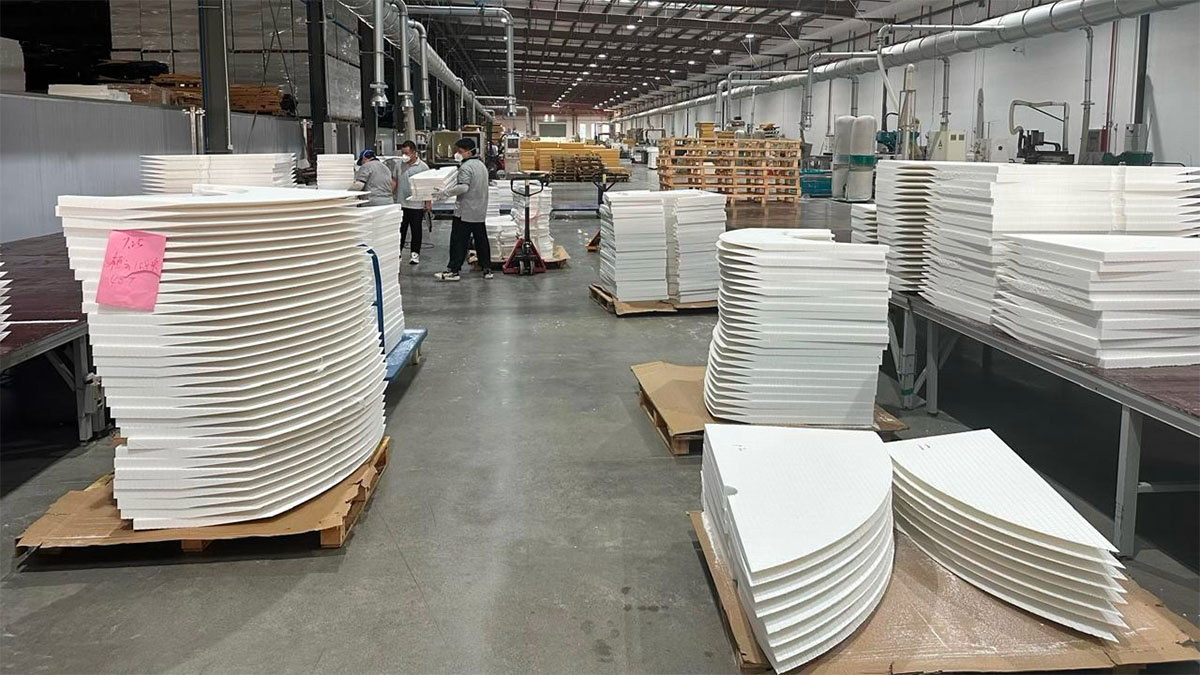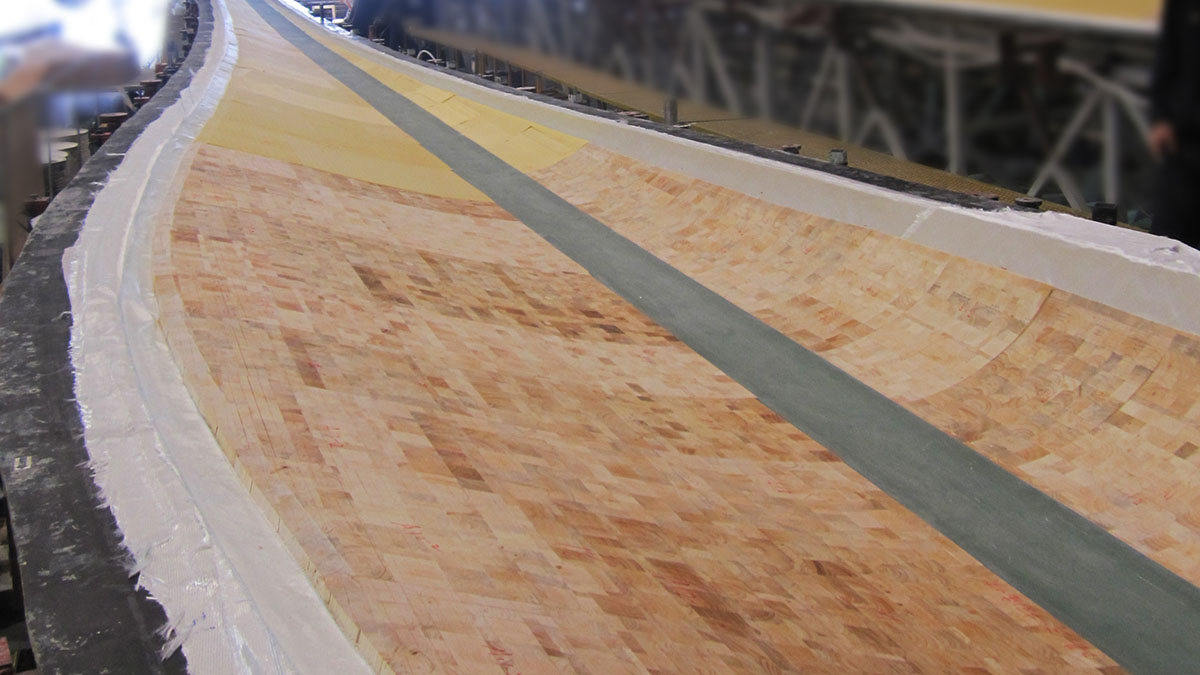In composite manufacturing, precision in core foam material processing is critical to achieving lightweight structures that combine strength, durability, and efficiency. This guide to core material processing highlights how Sky Composites supports industries with advanced cutting, slicing, perforating, and shaping methods that ensure consistent quality and performance. Beyond processing, the company specializes in kitting services—delivering pre-cut and sequenced core materials that streamline production. While these solutions are primarily tailored for the wind energy sector, they are increasingly applied in the marine industry as well, where efficiency and accuracy are equally essential.

Foam core material kits in production
Core foam materials overview
A wide range of foam core materials can be processed to meet the specific needs of composite applications. The most commonly used types include:
- PVC foam – valued for its balance of strength and low weight
- PET foam – offering recyclability and cost efficiency
- Balsa wood – known for its natural stiffness and high mechanical properties
- PMI foam – preferred in high-performance projects where low density and high heat resistance are required
These materials play a vital role across diverse industries. In marine applications, they are used in hulls, decks, and superstructures to ensure durability in demanding conditions. The wind energy sector relies heavily on foam cores for turbine blades, where precision and weight savings directly influence performance. In transportation, lightweight panels enhance fuel efficiency, while in industrial uses, foam cores provide structural stability without unnecessary mass.
Guide to core material processing techniques
Cutting and Slicing Methods for Precise Shapes and Sizes
Accurate cutting and slicing are the foundation of core material processing. Using advanced equipment, including 5-axis cutting systems, core foam sheets are shaped into precise geometries that match the mold requirements. This ensures consistent thickness, clean edges, and minimal waste—critical factors for large-scale applications such as wind turbine blades and marine hulls.
Perforations and Grooves: Design and Benefits
Perforating and grooving are specialized techniques that enhance both the functionality and performance of composite structures. Perforations allow for controlled resin flow and efficient air evacuation during lamination, while grooves reduce weight and improve resin distribution. Together, these features not only minimize the risk of voids but also optimize the structural balance between strength and weight.
Thermoforming and Shaping
Thermoforming involves heating foam cores to the appropriate temperature range, forming them over a mold, and cooling under controlled conditions. This process allows materials to adapt seamlessly to complex, curved shapes without excessive cuts or joints. Proper temperature control is essential, as it ensures dimensional stability and prevents resin overconsumption. Thermoforming is widely applied in large structures such as marine components and wind energy blades.

Thermoforming and shaping of balsa core in a large composite mold
Compression Molding and Vacuum Forming
For projects requiring high dimensional accuracy, compression molding and vacuum forming offer advanced solutions. Compression molding uses heat and pressure to form the core into exact geometries, while vacuum forming ensures consistent compaction across the entire surface. These processes not only improve mechanical performance but also reduce variations, making them ideal for demanding aerospace, wind energy, and industrial applications.
Machining Options
In addition to standard cutting, a range of machining options allows for highly customized processing. Techniques such as chamfering, milling, grooving, perforating, gluing or welding, scrim application, and slicing provide design flexibility while maintaining structural integrity. By combining these machining methods, core materials can be tailored to meet the specific requirements of each composite project, from lightweight panels to complex multi-layered structures.
Benefits of core material finishing
Core material finishing provides several advantages that directly improve the performance and efficiency of composite manufacturing. Enhanced formability allows the material to adapt to complex molds, minimizing the need for excessive cutting or adjustments. Features such as perforations and grooves ensure optimized resin flow, reducing material consumption while preventing voids or excess buildup. These processes also contribute to significant weight savings without compromising structural strength, making them particularly valuable in applications where every gram counts. Finally, finishing improves surface quality and bonding reliability, resulting in stronger adhesion between core and laminates and a smoother, defect-free finish in the final product.
Kitting: customized solutions for efficiency
Kitting is one of the most effective ways to streamline composite manufacturing, ensuring that every core material component arrives pre-cut, labeled, and sequenced for immediate use.
At Sky Composites, kitting is primarily designed for the wind energy sector—where the size and complexity of turbine blades demand precise preparation—but the service is increasingly adopted in the marine industry as well.
By reducing cutting waste, labor time, and assembly errors, kitting not only accelerates production but also improves consistency and quality. Each kit comes with detailed instructions and optimized packaging, enabling manufacturers to move quickly from preparation to assembly with minimal effort and maximum efficiency.
Sky Composites’ Global Expertise and Quality Assurance
With more than 30 years of experience, Sky Composites operates a strong international network across the USA, China, and Hungary. The company’s services are backed by certified quality standards, including GL, DNV, and ISO, ensuring consistent performance and reliability across every project. By also offering sustainable material options, Sky Composites helps manufacturers balance environmental responsibility with technical excellence.
Conclusion
Professional core material processing is essential to achieving lightweight, strong, and efficient composite structures. From wind energy and marine to transportation and other industrial applications, precise processing and kitting significantly reduce costs, waste, and assembly time while enhancing performance. With Sky Composites’ expertise and global reach, manufacturers gain a trusted partner for successful project outcomes. Contact Sky Composites today to explore how advanced processing and kitting solutions can support your next project.





